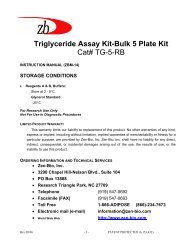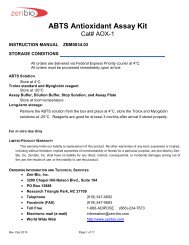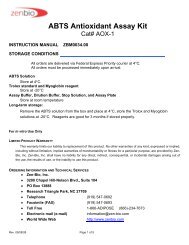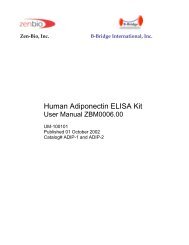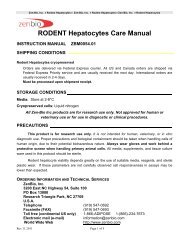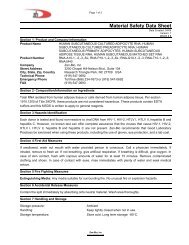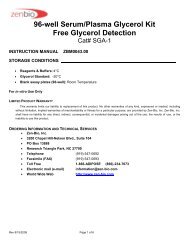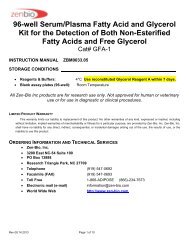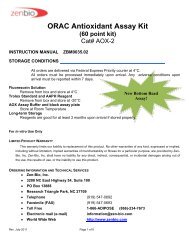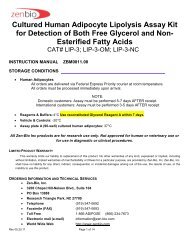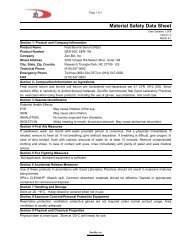Triglyceride Assay Kit Cat# TG-1-NC - Zen-Bio Inc.
Triglyceride Assay Kit Cat# TG-1-NC - Zen-Bio Inc.
Triglyceride Assay Kit Cat# TG-1-NC - Zen-Bio Inc.
You also want an ePaper? Increase the reach of your titles
YUMPU automatically turns print PDFs into web optimized ePapers that Google loves.
dilution serves as the highest standard, and the diluent serves as the zero standard.200 µl 125 µl 125 µl 125 µl 125 µl 125 µl 125 µlDiluentStd200 100 50 25 12.5 6.25 3.125µM µM µM µM µM µM µM9. Also at this time prepare the Reagent A by adding 11.0 ml deionized water per bottle andgently invert. DO NOT VORTEX! Use a pipet to insure that the powder is completelydissolved. Keep at room temperature. If using a Reagent A solution previously preparedand stored at 2-8°C, also bring to room temperature. Make sure there is enough ReagentA from one solution to treat all the points in the assay. It may be necessary to combinesolutions. Store in a light protected bottle. Reconstituted Glycerol Reagent A is stable for60 days refrigerated (2-8°C); store any remaining solution refrigerated (2-8°C).10. To a blank 96 well plate, add 80 µl wash buffer to each well needed for the assay (NOTE:do not add Wash Buffer to the wells used for the standard curve).11. Working with one row or column at a time, mix the lysates very well using a multi-channelpipet. Immediately transfer 20 µl per well of the lysates to the corresponding well of theplate containing the wash buffer. This results in a Dilution Factor of 5.12. Prepare the standard curve. Pipet 100 µl of each standard into a well. (NOTE: Eight wellsare necessary for the curve. If there are remaining wells on the assay plate, you can utilizethe remaining wells. If not, a second plate is included in this kit).13. Using the third tray, add 100 µl Reagent A to samples and standards. Mix by pipetting upand down one time. <strong>Inc</strong>ubate at room temperature for 15 minutes.14. Read at 540 nm using a microtiter plate reader.Rev. 09/06 - 4 - PATENT PROTECTED (6,153,432)
DATA ANALYSISThis kit is designed to show relative lipid accumulation of experimental treatments compared tocontrols. The assay is based on the equation1 M <strong>Triglyceride</strong> yields 1M glycerol + Free Fatty AcidsThe reagent measures the concentration of glycerol released after lysing the cells andhydrolyzing the triglyceride molecules. The triglyceride concentration can then be determinedfrom the glycerol values.Generate standard curve: see example below[DO NOT use this standard curve to generate your data. This is an example.]Subtract the OD value of the 0µM standard from all OD values including the standard curve.Zero(blank) = .040µMOD -blankGlycerol OD3.125 0.054 0.0146.25 0.066 0.02612.5 0.082 0.04225 0.138 0.09850 0.214 0.174100 0.402 0.362200 0.711 0.671slope = 0.0034intercept= 0.0075r 2 = 0.9985OD0.80.60.40.20.0Standard Curvey = 0.0034x + 0.0075R 2 = 0.99850 100 200 300Glycerol in uMy = observed O.D. minus the blankx = concentration of glycerol in µMTo calculate x for each y, (i.e. to change the observed O.D. into glycerol concentration) use thefollowing equation:y=(slope) times (x) plus intercepty=mx+b so x=(y-b)/mx=(y – 0.0075)/0.003 where 0.003= slope of the line and 0.0075= y intercept. Be careful to enterthe proper sign for the y intercept value as it may be a negative number.Any OD values greater than the highest standard (200 µM) should be suspect. The compoundshould be re-assayed using a lower dose of the compound at treatment OR a dilute solution ofthe condition medium at the time of the assay.Rev. 09/06 - 5 - PATENT PROTECTED (6,153,432)
The R 2 value should be equal or greater then 0.98 for the standard curve to be valid. AnyR 2 values below 0.98, must have the standard curve run again.Solve for the Total Glycerol concentration (i.e. total triglyceride concentration) for each OD.Remember to include the Dilution Factor in the equation. Data is expressed as µM Glycerol.NOTE: Any OD values that are negative after the blank is subtracted should be considered to be0 for the OD value. Also any OD values greater than the highest standard (200 µM) should besuspect. The compound should be re-assayed using a lower dose of the compound at treatmentOR a more dilute solution of the condition medium at the time of the assay.TROUBLESHOOTINGProblemHigh background or the triglyceridereagent turns a darker color beforethe assay begins.Edge effects<strong>Inc</strong>onsistent OD readingSuggestions• Use clean tray and tips• Change pipet tips frequently• Ensure a saturated humidity in the incubator toprevent evaporation from the outside wells• Be careful when pipetting to avoid bubbles. Ifbubbles persist, burst the bubbles using a largegauge needle prior to reading and read the plateagain.• Mix the lysates well before transferring the 20µlto the Wash buffer plate.REFERE<strong>NC</strong>ES1. Green, H. and Kehinde, O. (1974) Sublines of mouse 3T3 cells that accumulate lipid. Cell1, 113-116.2. Hauner, H., et al., (1989) J. Clin. Invest.(84), 1663-1670.3. Kuri-Harcuch W, Wise LS, Green H. (1978) Interruption of the adipose conversion of 3T3cells by biotin deficiency: differentiation without triglyceride accumulation. Cell 14:53-58.Rev. 09/06 - 6 - PATENT PROTECTED (6,153,432)
APPENDIX A : Plate layoutABCDEFGH1 2 3 4 5 6 7 8 9 10 11 12Rev. 09/06 - 7 - PATENT PROTECTED (6,153,432)
APPENDIX B: <strong>Triglyceride</strong> <strong>Assay</strong> FlowchartRemove all media from wellsWash with 150µl wash bufferRemove all wash buffer from wellsAdd 15µl lysis buffer<strong>Inc</strong>ubate 20 minutes37 – 50 o CVerify lysisAdd 135µl wash bufferAdd 20µl Reagent B. Gently tap plate to mix reagents<strong>Inc</strong>ubate 2 hours at 37 o COne hour prior to assay, reconstitute Glycerol Reagent Aand prepare standards. Keep all at room temp.Add 80 µl wash buffer to a new plate.Mix lysates and transfer 20 µl lysates to the wash buffer wells.Transfer 100 µl of each standard to a new plateAdd 100 µl Reagent A to samples and standards<strong>Inc</strong>ubate 15 minutesRoom TemperatureMeasure O.D. 540 nmRev. 09/06 - 8 - PATENT PROTECTED (6,153,432)



